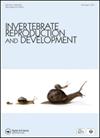Depot lipids in mature palinurid decapods (Crustacea)
IF 0.8
4区 生物学
Q4 REPRODUCTIVE BIOLOGY
引用次数: 7
Abstract
ABSTRACT Decapods form the backbone of global crustacean fisheries and aquaculture. Palinurids contribute a small percentage of global decapod catches but are of high commercial value. They are currently rarely cultured but some fast-growing tropical species are regarded as one of the “most promising emerging species for aquaculture”. Recent advances in palinurid aquaculture have raised interest in their metabolism, including that of depot lipids. Probably due to past difficulties in palinurid aquaculture, knowledge on lipid metabolism of adults is poor, especially when compared with commercially important aquacultural decapods. However, interpolation of data from other decapod infraorders such as penaeids, from which the bulk of knowledge on crustacean lipids is derived, is problematic. Palinurids have a completely different life cycle, demanding different metabolic requirements than related decapod taxa. Providing energy during moulting and gonad development, depot lipids play a central role in growth and reproduction of palinurids. The high relevance of lipid digestion and accumulation is indicated by the high hepatopancreas lipid content (higher than in other decapod taxa) and the increasing importance of lipids with ontogenesis. The present review intends to provide an overview of the currently available information on the role of those depot lipids in the biology of mature palinurid decapods and regulation of their metabolism.成熟palinurid十足类动物(甲壳类)的储存脂质
十足类动物是全球甲壳类渔业和水产养殖业的支柱。Palinurids在全球十足类渔获量中所占比例很小,但具有很高的商业价值。它们目前很少被养殖,但一些快速生长的热带物种被认为是“最有希望用于水产养殖的新兴物种”之一。近年来在palinurid水产养殖方面的进展引起了人们对其代谢的兴趣,包括储存脂质的代谢。可能是由于过去在palinurid养殖中遇到的困难,关于成虫脂质代谢的知识很少,特别是与商业上重要的养殖十足动物相比。然而,从其他十足类的下目,如对甲壳类动物脂类的大部分知识来源于对甲壳类动物的对甲壳类动物的数据的插值是有问题的。Palinurids具有完全不同的生命周期,与相关的十足动物类群需要不同的代谢需求。储存脂质在脱毛和性腺发育过程中提供能量,在palinurids的生长和繁殖中起着核心作用。脂质消化和积累与肝胰腺脂质含量高(高于其他十足动物类群)和脂质在个体发生中的重要性日益增加有关。本文就其在成熟棕榈科十足动物生物学中的作用及其代谢调控的研究进展作一综述。
本文章由计算机程序翻译,如有差异,请以英文原文为准。
求助全文
约1分钟内获得全文
求助全文
来源期刊
CiteScore
1.90
自引率
0.00%
发文量
21
审稿时长
>12 weeks
期刊介绍:
Invertebrate Reproduction & Development ( IRD) presents original research on the reproductive and developmental biology of the Invertebrata, both embryonic and postembryonic. IRD welcomes papers reporting significant results obtained using new techniques. Encouraged topic areas include: aquaculture, physiology, biochemistry, functional morphology, phylogeny, behavioural and regulatory mechanisms, including genetic, endocrine and molecular studies. Papers containing qualitative descriptions of reproductive cycles and gametogenesis will not be considered. IRD is published in association with the International Society of Invertebrate Reproduction and Development.

 求助内容:
求助内容: 应助结果提醒方式:
应助结果提醒方式:


